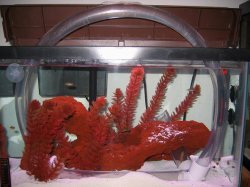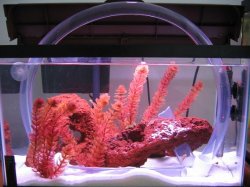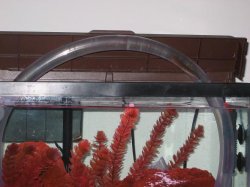You are using an out of date browser. It may not display this or other websites correctly.
You should upgrade or use an alternative browser.
You should upgrade or use an alternative browser.
10G Setup
- Thread starter myenigmaself
- Start date
myenigmaself
Fishaholic
myenigmaself
Fishaholic
myenigmaself
Fishaholic
Info: it's vinal tubing I picked up at Home Depot. 1" inner, 1 1/4" outer. Connected by standard PVC joints. Eventually I'm planning on having 3" clear PVC pipes in a similar fassion or connecting two tanks. At $10/foot plus shipping chages it might be a little time before I experiment with that 
Yeah do i wanna see them.55gallondude said:WOW that looks so cool Take a picture of them swimming inside it.
OscarCichlid
Fish Crazy
Im still a little confused about how the water stays in the tubes above the water line of the tank.
Synastic
Fish Addict

Stryker
Fishaholic
Oscarchild.
Its all about air pressure. I dont know the science, but the pressure of our atmosphere is pressing on the water surface of the tank. So you have that pressure over the whole of the tanks water surface versus the weight of the water in the part of the pipe that goes above the tanks water level..... really its no contest.
Interesting enough if you lift your hand up in the air, its lifting the equiv of a large sack of potatoes. Only difference is that sack of potatoes pressure is excerted from all directions hence why you can move.
Here is an experiment:
Fill your sink with water.
Get a bottle or even a jug.
Put it under the water and allow the water to enter.
Now turn it upside down so the opening when the water went in is facing down.
Now notice how you can lift the bottle/jug full of water right up until its opening is just below the surface of the water in your sink...... same thing as those pipes.
Its all about air pressure. I dont know the science, but the pressure of our atmosphere is pressing on the water surface of the tank. So you have that pressure over the whole of the tanks water surface versus the weight of the water in the part of the pipe that goes above the tanks water level..... really its no contest.
Interesting enough if you lift your hand up in the air, its lifting the equiv of a large sack of potatoes. Only difference is that sack of potatoes pressure is excerted from all directions hence why you can move.
Here is an experiment:
Fill your sink with water.
Get a bottle or even a jug.
Put it under the water and allow the water to enter.
Now turn it upside down so the opening when the water went in is facing down.
Now notice how you can lift the bottle/jug full of water right up until its opening is just below the surface of the water in your sink...... same thing as those pipes.
myenigmaself
Fishaholic
Thanks for the props everybody  Stryker, very good explanation and experiment. There's another way to think about it (this though process doesn't explain going between tanks though). Just think about what could possibly be in the tube. For our purposes it is either water or air. The pipe is filled with water and both ends are submerged in water. How can air possibly get into the tube? It can't, hence our state of equilibrium
Stryker, very good explanation and experiment. There's another way to think about it (this though process doesn't explain going between tanks though). Just think about what could possibly be in the tube. For our purposes it is either water or air. The pipe is filled with water and both ends are submerged in water. How can air possibly get into the tube? It can't, hence our state of equilibrium 
A more scientific explanation is that gravity is exerting a downward force on all things on the face of the planet, including water and air. Since water has a greater mass (per volume) it has a greater weight (mass * gravity). Pressure, in this sense, is all about density (mass per volume). The water has a greater density, and thus a greater force per volume pulling on it, and subsequently gets pulled through the air until it reaches a substance of even greater density (or a rigidity that prevents fluid from flowing, such as your fish tank). When you fill the tube with water and lift the middle out of the water there are two important forces in play:
1) Gravity pulling the water from the tube (and also pulling on the air, but that's inconsequential).
2) Molecular ionic forces holding the water molecules together.
Since the sum of the force of the water pushing down is greater at the openings of the tube than in the rest of the tank (because it's got the height of the water line, plus the water above the water line pushing down) one would think that the water would flow out. But, since there is nothing of lesser density to replace water in the tube there is actually a suction force (the molecular force I mentioned earlier) that holds the water in place. This equalizes the forces pulling the water out of the tube, and viola, you have a water arch
As for a siphon, say you've got one tank with a water level of 10cm, and another tank with a water level of 20cm (pretend the tanks are the same dimensions, just not filled the whole way). There is 10cm of water pushing down on the first tank, where there is 20cm of water pushing down on the second tank. This creates a pressure differential and water will flow from the 20cm tank to the 10cm tank until the pressures are equal, giving you two 15cm tanks.
Such is the magic of science
Hope that wasn't overkill, nor that I'm grossly inaccurate
A more scientific explanation is that gravity is exerting a downward force on all things on the face of the planet, including water and air. Since water has a greater mass (per volume) it has a greater weight (mass * gravity). Pressure, in this sense, is all about density (mass per volume). The water has a greater density, and thus a greater force per volume pulling on it, and subsequently gets pulled through the air until it reaches a substance of even greater density (or a rigidity that prevents fluid from flowing, such as your fish tank). When you fill the tube with water and lift the middle out of the water there are two important forces in play:
1) Gravity pulling the water from the tube (and also pulling on the air, but that's inconsequential).
2) Molecular ionic forces holding the water molecules together.
Since the sum of the force of the water pushing down is greater at the openings of the tube than in the rest of the tank (because it's got the height of the water line, plus the water above the water line pushing down) one would think that the water would flow out. But, since there is nothing of lesser density to replace water in the tube there is actually a suction force (the molecular force I mentioned earlier) that holds the water in place. This equalizes the forces pulling the water out of the tube, and viola, you have a water arch
As for a siphon, say you've got one tank with a water level of 10cm, and another tank with a water level of 20cm (pretend the tanks are the same dimensions, just not filled the whole way). There is 10cm of water pushing down on the first tank, where there is 20cm of water pushing down on the second tank. This creates a pressure differential and water will flow from the 20cm tank to the 10cm tank until the pressures are equal, giving you two 15cm tanks.
Such is the magic of science
Hope that wasn't overkill, nor that I'm grossly inaccurate

Thanks for the info on the vinal tubing. I want to make UG tunnels for my cory cats!
I had a dream about your puffers using the tubes you made. Two of them were having a party at the highest point inside the tubes (above your tank). They loved the tubes
I had a dream about your puffers using the tubes you made. Two of them were having a party at the highest point inside the tubes (above your tank). They loved the tubes

DrOizo
Fish Addict
Has anyone swum above the tank yet??? A novel idea!
myenigmaself
Fishaholic
My gold algae eater has made the trip around the loop! He's the only one I've seen thus far. The crazy thing is he barely comes out of the tubes!! He loves it in there. It's his new home. I haven't been able to squeeze off a picture though. Seeing how the tube is clear, and he has good eyesight, is very skiddish, and moves like lightning! I'll get one as soon as I can 
myenigmaself
Fishaholic
myenigmaself
Fishaholic
myenigmaself
Fishaholic
Similar threads
- Replies
- 8
- Views
- 509
- Replies
- 43
- Views
- 1K







